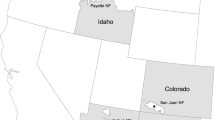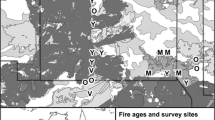Abstract
Vegetation typical of the tallgrass prairie occurs east of the Great Plains in bottomland “openings” and as small “glades” or “balds” within the eastern deciduous forest. West of the Mississippi River, however, coverage by tallgrass prairie expands with the increasingly greater aridity under the deepening rainshadow of the western mountains. Along the Kansas-Missouri border on the western fringe of the deciduous forest, prairie is present across 50–80% of the region (Schroeder 1983). Forested area within this prairie-forest mosaic continues to diminish, decreasing to as little as 7% in the Flint Hills Uplands (Knight et al. 1994). The portion of the Great Plains characterized by the tallgrass prairie community exists in a climate that allows the development of forest as a bordering “gallery” along stream courses. These naturally occurring forest fragments, these island remnants of the continental forest to the east, remain an integral aspect of the tallgrass prairie landscape, contributing a disproportionately greater component, considering the small extent of their coverage, to the regional avian species richness (Faanes 1984, Zimmerman 1993).
Access this chapter
Tax calculation will be finalised at checkout
Purchases are for personal use only
Preview
Unable to display preview. Download preview PDF.
Similar content being viewed by others
References
Abrams, M.D., and L.C. Hulbert. 1987. Effect of topographic position and fire on species composition in tallgrass prairie in northeast Kansas. Am. Midl. Nat. 117:442–445.
Anderson, K.L., E.F. Smith, and C.E. Owensby. 1970. Burning bluestem range. J. Range Manage. 23:81–92.
Anderson, R.C. 1990. The historic role of fire in North American grassland. Pp. 8–18 in S.L. Collins and L.L. Wallace, eds. Fire in North American tallgrass prairie. Univ. Oklahoma Press, Norman.
Askins, R.A. 1993. Population trends in grassland, shrubland, and forest birds in eastern North America. Current Ornithol. 11:1–34.
Briggs, J.M., T.R. Seastedt, and D.J. Gibson. 1989. Comparative analysis of temporal and spatial variability in above-ground production in a deciduous forest and prairie. Holarctic Ecol. 12:130–136.
Cody, M.L. 1966. The consistency of intra- and inter-continental grassland bird species counts. Am. Nat. 100:371–376.
Cody, M.L. 1968. On the methods of resource division in grassland bird communities. Am. Nat. 102:107–147.
Collins, S.L., and D.J. Gibson. 1990. Effects of fire on community structure in tallgrass and mixed-grass prairie. Pp. 81–98 in S.L. Collins and L.L. Wallace, eds. Fire in North American tallgrass prairie. Univ. Oklahoma Press, Norman.
Faanes, C.A. 1984. Wooded islands in a sea of prairie. Am. Birds 38:3–6.
Hulbert, L.C. 1988. Causes of fire effects in tallgrass prairie. Ecology 69:46–58.
Johnson, D.H. 1979. Estimating nest success: the Mayfield method and an alternative. Auk 96:651–661.
Knapp, A.K., and T.R. Seastedt. 1986. Detritus accumulation limits productivity of tallgrass prairie. BioScience 36:662–668.
Knight, C.L., J.M. Briggs, and M.D. Nellis. 1994. Expansion of gallery forest on Konza Prairie Research Natural Area, Kansas, USA. Landscape Ecol. 9:117–125.
Knopf, F.L. 1994. Avian assemblages on altered grasslands. Stud. Avian Biol. 15:247–257.
Mayfield, H. 1961. Nesting success calculated from exposure. Wilson Bull.73:255–261.
Mayfield, H. 1975. Suggestions for calculating nest success. Wilson Bull. 87:456–466.
Mengel, R.M. 1970. The North American central plains as an isolating agent in bird speciation. Pp. 279–340 in W. Dort Jr. and J.K. Jones Jr., eds. Pleistocene and Recent environments of the central Great Plains. Univ. Kansas Publ. 3. Dept. Geology, Lawrence.
Miller, C.K., T.L. Knight, L.C. McEwen, and T.L. George. 1994. Responses of nesting Savannah Sparrows to fluctuations in grasshopper densities in interior Alaska. Auk 111:962–969.
Ralph, C.J., G.R. Geupel, P. Pyle, T.E. Martin, and D.F. DeSante. 1992. Field methods for monitoring landbirds. USDA For. Serv. Redwood Sci. Lab., Arcata, CA.
Schroeder, W.A. 1983. Presettlement prairie of Missouri. Missouri Dept. Conserv. Nat. Hist. Ser. 2. Jefferson City, MO.
Temple, S.A. 1990. Sources and sinks for regional bird populations. Passenger Pigeon 52:35–37.
Thompson, C.F., and V. Nolan Jr. 1973. Population biology of the Yellow-breasted Chat (Icteria virens L.) in southern Indiana. Ecol. Monogr. 43:145–171.
Wells, P.V. 1970. Historical factors controlling vegetation patterns and floristic distributions in the central plains region of North America. Pp. 211–240 in W. Dort Jr., and J.K. Jones Jr., eds. Pleistocene and Recent environments in the central Great Plains. Univ. Kansas Publ. 3. Dept. Geology, Lawrence.
Wiens, J.A. 1973. Pattern and process in grassland bird communities. Ecol. Monogr. 43:237–270.
Wiens, J.A. 1974. Climatic instability and the “ecological saturation” of bird communities in North American grasslands. Condor 76:385–400.
Wiens, J.A., and M.I. Dyer. 1975. Rangeland avifaunas: their composition, energetics, and role in the ecosystem. Pp. 146–182 in D.R. Smith, tech. coord. Proc. Symp. Manage, of For. and Range Hab. for Nongame Birds. USDA For. Serv. Gen. Tech. Rep. WO-1. Washington, DC.
Zimmerman, J.L. 1965. The bioenergetics of the Dickcissel, Spiza americana. Physiol. Zool. 38:370–389.
Zimmerman, J.L. 1971. The territory and its density dependent effect in Spiza americana. Auk 88:591–612.
Zimmerman, J.L. 1982. Nesting success of Dickcissels (Spiza americana) in preferred and less preferred habitats. Auk 99:292–298.
Zimmerman, J.L. 1988. Breeding season habitat selection by the Henslow’s Sparrow (Ammodramus henslowii) in Kansas. Wilson Bull. 100:17–24.
Zimmerman, J.L. 1992. Density-independent factors affecting the avian diversity of the tallgrass prairie community. Wilson Bull. 104:85–94.
Zimmerman, J.L. 1993. The birds of Konza: the avian ecology of the tallgrass prairie. Univ. Press Kansas, Lawrence.
Editor information
Editors and Affiliations
Rights and permissions
Copyright information
© 1997 Springer Science+Business Media New York
About this chapter
Cite this chapter
Zimmerman, J.L. (1997). Avian Community Responses to Fire, Grazing, and Drought in the Tallgrass Prairie. In: Knopf, F.L., Samson, F.B. (eds) Ecology and Conservation of Great Plains Vertebrates. Ecological Studies, vol 125. Springer, New York, NY. https://doi.org/10.1007/978-1-4757-2703-6_7
Download citation
DOI: https://doi.org/10.1007/978-1-4757-2703-6_7
Publisher Name: Springer, New York, NY
Print ISBN: 978-1-4419-2851-1
Online ISBN: 978-1-4757-2703-6
eBook Packages: Springer Book Archive




